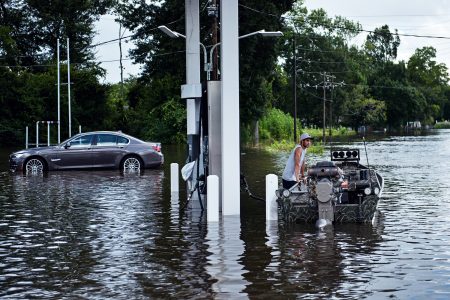August 22, 2016 – A once in 500 year storm doesn’t necessarily point to climate change, but for those teetering on the edge between denial and belief, it certainly tips the balance to the latter. I, for one, categorically state that a rainstorm on its own is no indicator of global warming. But the ever creeping changes in extreme weather and excessively warm temperatures over the last few years are probably smoking gun evidence.
The people of southern Louisiana can’t seem to catch a break. The rising waters in the lower Mississippi River basin have covered roads, breached levees, killed 13 people, and inundated more than 60,000 homes. Described as a once-in-500 year rainfall, it is the eighth time this year that the United States has been on the receiving end of such a weather event. The reinsurance industry right now is probably recalculating probabilities on what the future holds. If I were living in Louisiana and paying flood insurance I wouldn’t want to see what next year’s premium will cost.
The problem with Louisiana is simple. The lower Mississippi River basin is sinking. People have built their communities on a flood plain. And flood risk is spreading. When the waters subside Louisiana’s citizens will return to their ruined homes and rebuild. Hopefully they will be smart to build their houses on stilts or move and build away from flood prone lowlands. If not then they will find themselves paying significantly higher premiums to cover potential 500-year floods that may occur several times in the next decade.
But more insidious is what the floods may bring in addition to water-damaged homes and loss of livelihood. American health officials see the Louisiana floods as a disease threat with Zika, Dengue and other mosquito-borne viruses spreading across the Gulf of Mexico lowlands. Zika, despite significant efforts to knock down the mosquito population through controlled aerial spraying, has already spread beyond initial containment in one Miami neighbourhood. The virus is more than likely to extend its infectious range with all the standing water now available to its host mosquito from the once in 500 year storm.
In the past Zika and Dengue were endemic to tropical and subtropical areas of the world. But the definition of what is tropical and subtropical is changing as global warming moves the latitude line limits away from the equator and closer to the poles. The result states Dr. Anthony Fauci, Director of the Allergy and Infectious Diseases Unit of the National Institute of Health, “It would not be surprising we would see additional cases perhaps in other Gulf Coast states…..There’s going to be a lot of problems getting rid of standing water.” Aedes aegypti, the Zika spreading mosquito, likes standing water and is active during daylight hours. So as people clean up after the flood they need to be cognizant of the potential threat to their health and protect themselves by covering up or using DEET or other mosquito repellents.
Zika in Brazil has been linked to microcephaly in newborn babies born to infected mothers. A Zika-infected person can transmit the virus to a sex partner. Zika is also linked to Guillain-Barre Syndrome, a neurological disease that causes temporary paralysis in infected adults.




















